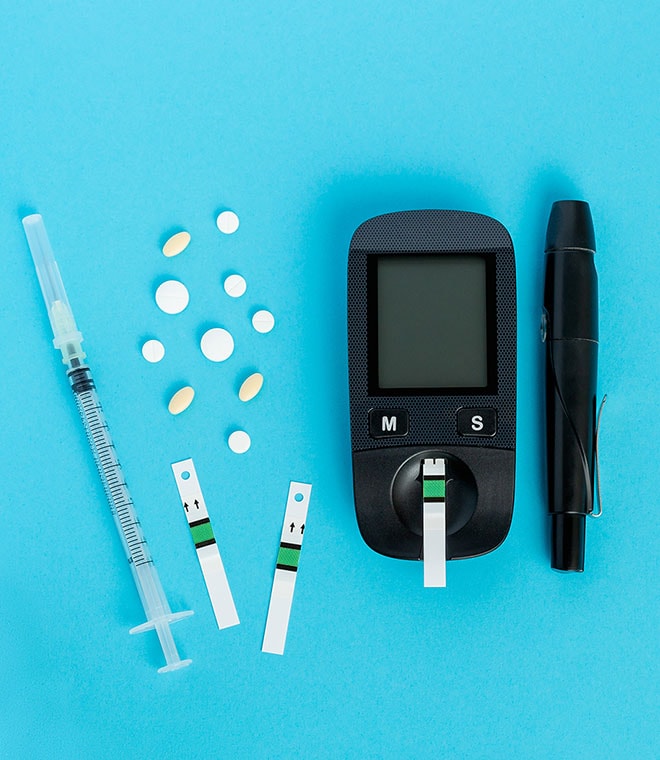Health
Keep your vision strong, even with diabetes
By Jenilee Matz, MPH Jun 11, 2024 • 7 min
Chronic high blood sugar levels in diabetes can cause serious complications throughout the whole body, including the eyes. In fact, one form of diabetic eye disease, called diabetic retinopathy, is the leading cause of impaired vision in adults ages 25 to 74. However, there are ways to protect your eyes to reduce your risk of losing your sight. Learn how diabetes can affect the eyes and how to guard your vision.
Diabetic eye disease basics
Over time, high blood sugar in diabetes can damage the blood vessels in your eyes. Damaged blood vessels can leak fluid and cause swelling, and new, weaker blood vessels may even start to grow. These blood vessels can bleed, causing scarring or dangerously high pressure inside your eyes. In addition, many people with diabetes also have high blood pressure, and prolonged high blood pressure levels can also harm the blood vessels that supply the eyes.
Your risk of diabetic eye disease increases the longer you have diabetes. Diabetic eye disease refers to a group of eye problems that can develop as a complication of diabetes. Each type can lead to partial or total vision loss. Diabetic eye disease includes:
- Diabetic retinopathy, the most common diabetic eye disease, occurs when there's damage to the blood vessels in the retina (the light-sensitive inner lining at the back of the eye). This can distort vision and lead to retinal detachment in its most advanced stage.
- Diabetic macular edema. The macula is the part of your eye that allows you to read, drive and see faces. Diabetes can cause the macula to swell, and it can even destroy the sharp vision in this part of the eye. Macular edema usually occurs as a result of diabetic retinopathy.
- Cataract is the clouding of the lens (part of the eye that helps to focus light on the retina), which is normally clear. While cataracts are very common with aging, people with diabetes tend to develop them earlier than other adults.
- Glaucoma refers to a group of diseases that increase fluid pressure inside the eye and damage the eye's optic nerve (more than one million nerve fibers that connect the retina to the brain). If you have diabetes, you're nearly twice as likely to get glaucoma as adults without diabetes.
Reduce your risk with regular eye care
It's crucial to have an eye doctor, either an optometrist or an ophthalmologist, on your healthcare team. Seeing your eye doctor as directed can help protect your eyesight. In its early stages, diabetic eye disease often doesn't cause symptoms, and by the time you notice vision loss, it often cannot be reversed.
Get your eyes checked at least once each year, or as often as your eye doctor recommends. Your exam should include dilating your pupils (the black center of your eyes) so that your doctor can see the back of your eyes and find problems early.
It's also important to see your eye doctor at the first sign of any vision problems. In some cases, early treatment of eye issues can prevent further vision loss. See your doctor if you:
- Have blurred vision
- Experience double vision
- Have trouble reading signs or books
- Feel pain in one or both eyes
- Develop redness in your eyes that doesn't go away
- Feel pressure in your eyes
- See spots or floaters
- Notice that straight lines no longer appear straight
- Cannot see things to the side as well as normal
Control your blood sugar, protect your vision
The best way to guard your eyesight is to follow your diabetes treatment plan as directed by your healthcare provider. Keeping your blood sugar levels near goal will help reduce your risk of eye problems and other diabetes-related complications. Manage diabetes well and care for your eyes by doing the following:
- Take insulin or other diabetes medications exactly as prescribed.
- Test your blood sugar as often as directed by your healthcare provider. This can help you know if your diabetes treatment plan is working.
- Reach and maintain a healthy weight, but know that even losing a small amount of weight can help improve your health.
- Adopt a diet rich in whole foods, including protein, non-starchy vegetables, dairy products, fruits and whole grains. Limit foods high in sugar, simple carbohydrates, saturated and trans fats, and sodium (salt).
- Get regular exercise. Strive to be active for at least 150 minutes per week, and try to break up long periods of sitting with spurts of movement.
- Quit smoking.
- Know your diabetes ABCs. "A" stands for hemoglobin A1C (your average blood sugar level over the past two to three months), "B" is for blood pressure and "C" is for cholesterol. High A1C, blood pressure and cholesterol levels each increase your risk for diabetic eye disease. Ask your healthcare provider what your ABC goals are, and follow your treatment plan to reach those targets.
Over time, uncontrolled diabetes can wreak havoc on your body, including your eyes. But take heart in knowing that having diabetes doesn't mean you're destined to lose your eyesight. Protect your vision by seeing your eye care doctor as often as recommended and following your diabetes treatment plan as directed.
Clinically reviewed and updated June 2024.
Sources:
- https://www.uptodate.com/contents/diabetic-retinopathy-prevention-and-treatment
- https://www.niddk.nih.gov/health-information/diabetes/overview/preventing-problems/diabetic-eye-disease
- https://www.diabetes.org/diabetes/eye-health
- https://care.diabetesjournals.org/content/41/Supplement_1/S38
- https://nei.nih.gov/health/diabetic/retinopathy
- https://www.nhlbi.nih.gov/health/educational/healthdisp/pdf/tipsheets/Control-the-ABCs-of-Diabetes.pdf
- https://www.niddk.nih.gov/health-information/diabetes/overview/healthy-living-with-diabetes



